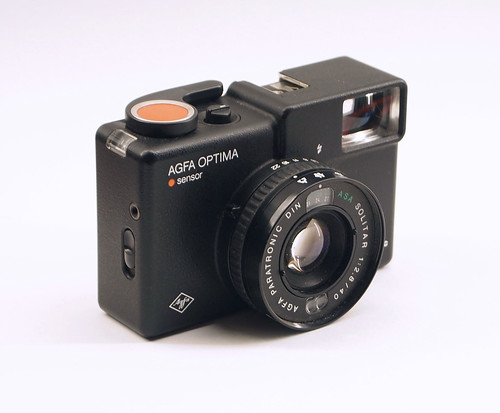 |
| Agfa Optima Sensor |
In 1959 Agfa produced the
Optima, the first 35mm camera with automatic exposure. A series of Optima models followed, and the name was continued with the Optima Sensor range, much more compact than the original Optimas. The final iteration of the cameras are those with model numbers ending with '35' in the name, with the exceptions of the flash model and the Agfa Optima Sensor.
The model pictured here is simply named 'Agfa Optima Sensor'. This is identical in design to the Optima Sensor 535, but produced by Agfa-Gevaert Portugal. It can be distinguished from the 535 by its lacking the model number on the camera's faceplate. The styling of the camera is quite distinctive. The body is metal but coated in black, which integrates the plastic parts, and its simple, clean lines are reminiscent of
classic Braun products from the 1960s. Indeed, despite being around 30 years old, I've had people initially think that the camera is digital.
The Optima Sensor has a 40mm f2.8 Solitar lens, stopping down to f22. The Paratronic shutter has speeds from 1/500th to 15 seconds. As exposure is automatic (controlled by a CDS cell, located below the lens within its filter ring) in use the apertures are only selected by the ring around the lens when using a flash, while a slow shutter speed is indicated by a red LED inside the viewfinder when the shutter button is partially depressed. (There may also be an over-exposure warning LED, but I have not experienced it). ISO is set above the lens, with numbers in DIN and ASA, from 25 ASA/15 DIN to 500 ASA/28 DIN.
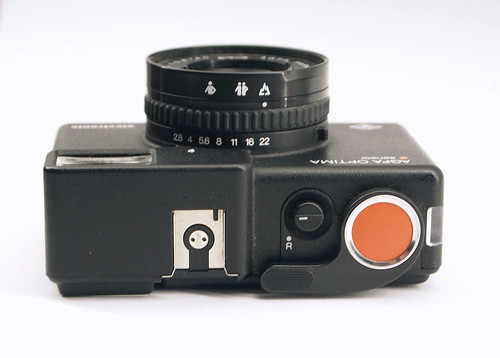 |
| Top view of the camera showing focus pictograms |
Focus is manual: looking down from above the camera, focus is assigned by three pictograms with click-stops: 'mountains' for infinity, 'group' at around 3.5m, and 'half-length' portrait at 1.5m. Interestingly though, on the underside of the lens there are numerical distances in both feet and metres, using which the lens can actually be focused closer than the half-length pictogram, down to 0.9m/3ft.
 |
| Underside of the lens with focus scales in metres and feet |
Two of the distinctive features common to all the Optima Sensor cameras are the large shutter button and the big viewfinder with parallax indicators for close subjects. The shutter has a pleasing sound when the button is depressed, but it does have one drawback as there is no 'lock' to the shutter button. In practice its large size means it is all too easy to accidentally press the button while in its soft case. One way to avoid this is simply not to wind on the camera after taking a picture before putting it away. The Optima Sensor also features a cable release on the user's right hand side, and a tripod mount on the other side doubles as a screw fitting for the proprietary strap, Being placed on one side, this does mean the camera is mounted in a portrait format when on a tripod. Another unusual feature to the Optima Sensor cameras is that the winding lever (located around the shutter button) also functions as the rewind, once the small 'R' button next to it is depressed and turned.
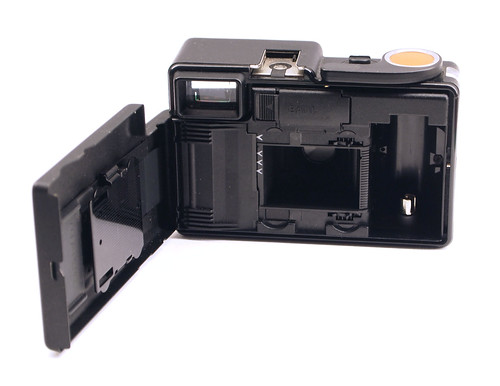 |
| View inside the opened camera |
Opening up the back of the camera, the interior layout is also distinctive. The film runs from right to left, in the opposite direction from most 35mm cameras. This means that frames on the film read right to left once developed, and the frame numbers in the film rebate appear upside-down. There is also a distinctive notch on the right hand side of the frame, which comes out on the frame when developed (I am unsure as to whether this has any purpose). The film does not need to be inserted into a take-up spool: when loading, the end of the film is simply inserted into a slot in the covered chamber on the left. This has the benefit of protecting the exposed film from light if the camera is inadvertently opened while a film is inside. It also means that very little film needs to be wound out of the cassette when loading (most 35mm cameras use at least a couple of frames' worth of film to load): I'm often able to get 40 exposures out of a roll of 36exp film.
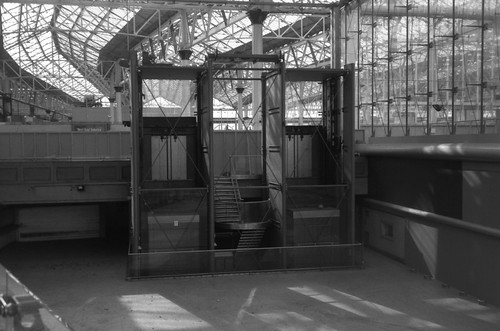 |
| Sample shot from the Agfa Optima Sensor on FP4 |
Having used an SLR for most of my photography when I was younger, the convenience of a compact camera is quite appealing. Some years ago I had been given a
Lomo LC-A, which had been my introduction (or perhaps reintroduction) to compact cameras, and while I appreciated its size and ease of use, I was less than enamoured with the vignetting and pincushion distortion (visible
here) of the LC-A's Minitar lens. I can't recall the process which lead me to the Agfa Optima Sensor, but I bought this from a well-known auction site for all of £6, and while not quite as compact as the LC-A, in all other respects it is far superior. It isn't the most sought after in the Optima Sensor series (the
1535 model which has a rangefinder is considered - and numbered - top of the range), but it's a small, cleverly designed and reliable camera.
 |
| Sample shot on HP5 with close focus down to 0.9m |
Edit 3/2/18 - further examples.
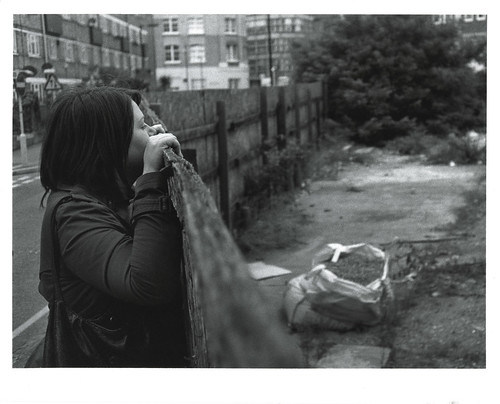 |
| Agfa Optima Sensor with Ilford FP4 Plus, scan from print |
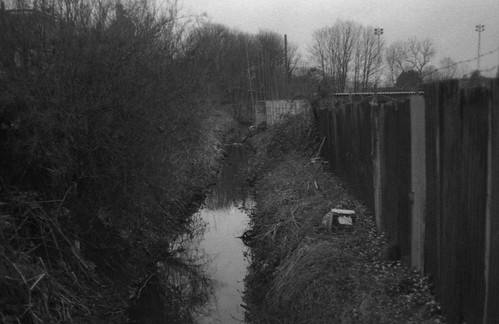 |
| Agfa Optima Sensor with Ilford Mark V motion picture film |
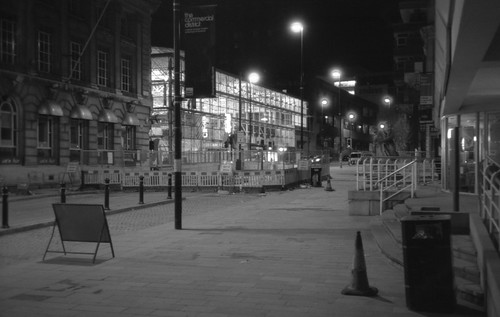 |
| Agfa Optima Sensor with Ilford FP4 Plus |
 |
| Agfa Optima Sensor with Rollei Retro 100 (Agfapan APX100) |
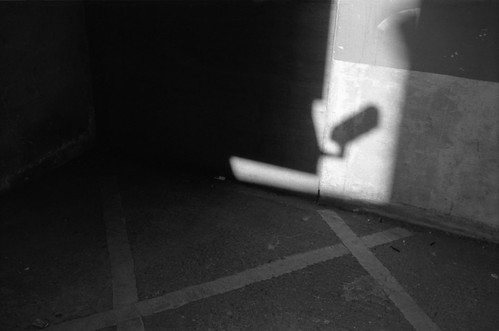 |
| Agfa Optima Sensor with Ilford FP4 Plus pushed to 200 |
 |
| Agfa Optima Sensor with Superpan 200 |
Sources/further reading:
Optima Sensor Camera on Camera-Wiki
Agfa Optima Sensor on Collections Appareils (French)
Agfa Optima 535 35mm-compact.com (French)












Yo tengo una Agfa optima sensor electronic que funciona correctamente, pero en ninguna circunstancia de luz ha llegado a 15 segundos (máximo 4 segundos). ¿Su cámara llega a los 15 segundos ?.
ReplyDeleteUn saludo.
Thank you for your comment. I don't think I have ever actually achieved a 15 second exposure, it may depend on the ASA/DIN selected. The only long exposure shots I have taken with this camera do seem to be correctly exposed, but the 15 second specification was simply something I read online.
ReplyDeleteI notice there is a little push bar in the hotshoe (presumably to switch off the auto aperture when a flash is attached) - do you suppose that 'tricking' the camera by pushing this in so that the aperture can be set manually, will produce under exposed shots as it is expecting a flash to go off?
ReplyDeleteInteresting idea - it does appear that this is the case. It does mean that depending on the film used and the aperture selected it could either be under or overexposed - although I can't find any information as to what the flash sync speed would be, but a reasonable assumption would be 1/30th-1/60th.
DeleteWell, I've done it with just over half of a roll of film (36exp/400/colour) that I've been using to test whether my camera is viable - so we shall find out once I've got the film developed...
DeleteSomeone else will have to try as it seems my camera is a dud... It didn't expose any of the film so I guess the electronics are knackered... :/
Delete